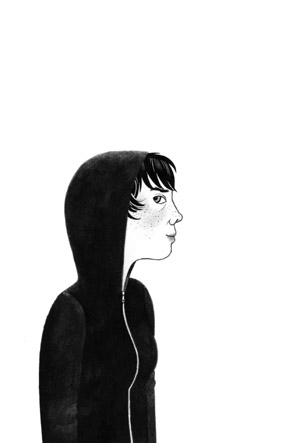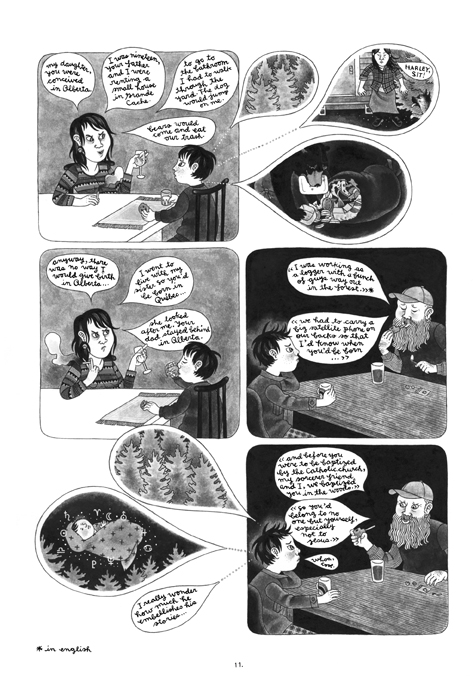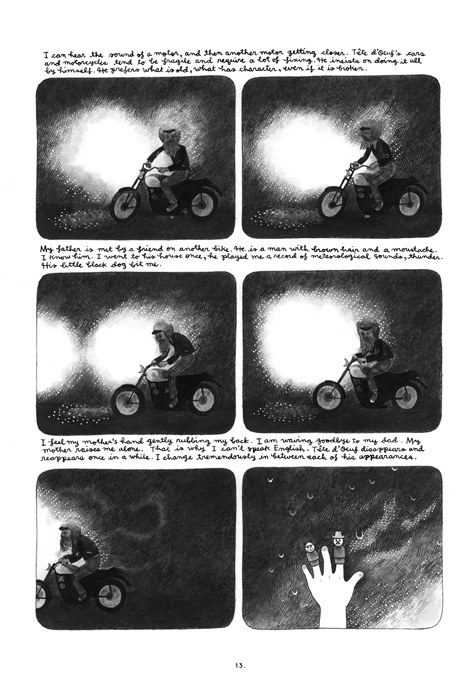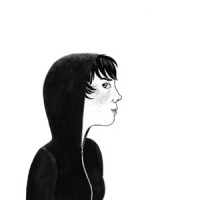
The work of Geneviève Castrée encompasses art, music, and comics, all of which share a common defiance of tradition. It’s idiosyncratic and deeply compelling, no matter the media where one encounters it. Most recently, she is the author of the autobiographical graphic novel Susceptible, which follows its protagonist Goglu through her childhood. That experience is a more hazardous one than it seems: her mother loses herself in intoxication and a neverending bad relationship. Throughout, there are glimmers of hope: Goglu’s discovery of punk rock among them. I caught up with Castrée via email to discuss her various projects.
Looking at the title of Susceptible, I find myself interpreting it in different ways. Does it apply to the ways that Goglu is hamstrung by circumstances; the way the adults are prone to moments of weakness; or something entirely different?
The title is meant to be applied to all the characters, but originally when I started working the book I was only thinking of Goglu. In Québec the French word “susceptible” is often used to describe a hyper-sensitive person, a person with a quick temper. I liked that about it. I liked starting out the story with a feeling of “Blame the kid. She was born damaged.”
The plant metaphor that opens the book is immediately striking: both beautiful and intensely painful to look at. How did you first come up with it?
To me the plant in the introduction is a bit of a cliché, and I am fine with it. I needed something easily understandable to the reader. I had an organic gardening magazine at my house with tips on how to grow squash. It had many beautiful photos of squash plants with blossoms. I guess I liked that some squashes are native to North America. That was important to me. My thinking process here is disappointingly transparent.

When structuring Susceptible, did you first work on the individual vignettes and then arrange them, or did you have a more set structure in mind?
I get very lazy about drawing the same thing too many times, and also I don’t like being stuck in panels. To make this book I wrote out a long list of memories which felt worthy of sharing. Then I scratched out what I thought was redundant, petty, or impossible to draw in comic form. The memories came as fragments. I didn’t always remember what happened the day before or the week after, but I had a timeline. Other memorable events like birthdays, Christmas, what grade I was in and what town I lived in allowed me to stick to the timeline fairly easily. I guess there were so many intense feeling moments that specific eras of my childhood are more defined for me than they would be for other people my age.
To what extent do you have the composition of pages figured out before you begin drawing them?
For each page I do a very rough sketch of the layout, with rough panels and what I want in them. Because I don’t like that part very much I make the sketches really really small, it saves time and I can still remember what they mean. The rest is in my head. Then I start penciling, a clear line, on the actual page, on bristol board.
In the second half of the book, when you have a few scenes in which Goglu is far from sober, how did you go about reflecting those states of mind in visual terms?
I am not sure… The way I went about it is what you see in the book! Mostly what I remember from my childhood when I think of the “bad vibes” is a feeling of fainting. If an adult was yelling at me, if I had done something bad which would require a punishment, I would feel the blood leaving my head. When I started being clinically depressed, when my grades dropped, and when I started experimenting with harder drugs the same feeling returned. It’s a dizzying tingling sensation accompanied by nausea. The drawing I did of myself passed out under a table, the one with the grey gradients and the white dots, is as close as I got to describing that feeling visually.

You’ve curated exhibits of artwork in Anacortes. Have other artists making comics also found their way there over the years?
I have only curated one exhibition and it is the one that is up right now. I have been one of the three main curators of a summer music festival here in town for the past twelve years but that’s it. Some cartoonists have come to Anacortes, but only as visitors. Anders Nilsen visited a couple summers ago, Gabrielle Bell and Tom Kaczynski were here last October. That’s pretty much it. I wish people came more often, or for longer, but there aren’t that many reasons to be in Anacortes. In the summer this place is magical. It’s small but we have a few lakes which are wonderful for swimming. Days get filled with BADMIMPIM (a new version of badminton my friends and I invented), eating fresh local vegetables, swimming, and probably something involving music, drawing or printing in some way or another. In the winter we all go back inside and stop seeing our friends, even the ones who live in town, for months at a time. It gets pretty lonely and dark. You can see it on people’s face, their brain fogs up, just like the sky. It’s important to keep busy and leave town once in a while so you don’t lose all your social skills.
Do you find that there’s any overlap of themes or images between your comics work and the music that you make as Ô PAON?
This is a very popular question. I think it might be confusing when people do more than one thing. “What are you? A cartoonist? A musician?”. I see my music and drawings as two distinct entities. They require different types of thinking, different aptitudes. Each one is fueled by different aspects of my personality. Something that I am learning is that as show-offy as it is to perform songs in front of an audience, I prefer it to talking in front of a crowd. When I make music there is still a part of it which feels private, hidden, secret, it isn’t so interactive, so outgoing. I talk more than most cartoonists, but it comes at a price. It’s draining and disorienting. Music is cathartic and rewarding. And then nothing beats being alone in my studio, zoning out on drawings for hours. I listen to audiobooks or podcasts and sometimes the sense of peace and quiet makes me feel like my life is so rich. The months following me putting the finishing touches on Susceptible have been pretty chaotic. I can’t wait to get back to work, really.
Artwork: Geneviève Castrée
Follow Vol. 1 Brooklyn on Twitter, Facebook, Google +, our Tumblr, and sign up for our mailing list.

